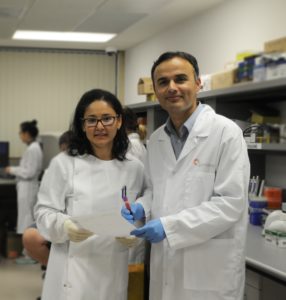
Co-investigators Associate Professor Elin Gray and Clinical Professor Adnan Khattak
PD-L1 expression on circulating tumour cells (CTCs) in advanced melanoma appears to be predictive of patient response to pembrolizumab and an independent biomarker of progression-free survival, Australian research shows.
A small WA study of 40 patients commencing on pembrolizumab therapy for mostly first and second line therapy was able to detect CTCs in 63% of cases.
The study found CTCs were highly heterogeneous, but commonly expressing the tumour initiating markers ABCB5 and/or RANK.
PD-L1 was identified in 64% of patients with detectable CTCs at baseline.
The study found patients with PDL1+ CTCs had significantly longer PFS compared with patients with PD-L1− CTCs (HR 0.162; p=0.009;).
“The median PFS for the PD-L1− CTCs group was 5.5 (5.2–5.8) months, whereas median PFS was not reached for the group with PD-L1+ CTCs.”
“The 12-month PFS rates were 81% versus 22% in the PD-L1+ versus PD-L1− CTCs groups, respectively (p = .034).”
The study also found the total number of CTCs was similar in both responders and non-responders while the number of PD-L1+CTCs was significantly higher in responders.
“Among patients with detectable CTCs, patients with PD-L1+ CTCs were eight times more likely to be responders compared with patients with undetectable PD-L1+ CTCs (OR, 8.67; 95%CI 1.19-342.96; p=.017).”
The total number of CTCs and proportion expressing PD-L1 decreased with treatment in most responders and increased or remained stable in most nonresponders.
The study said their findings indicated that PD-L1 positivity in CTCs is an independent predictor of response and prolonged PFS in patients with melanoma treated with pembrolizumab.
“CTC based PD-L1 status was superior to other baseline clinical parameters associated with response and prognosis, including lactate dehydrogenase, disease stage, and ECOG performance status,” it said.
It therefore offered the potential as a future noninvasive real-time biopsy to evaluate PD-L1 expression in patients with melanoma.
Senior investigator Associate Professor Elin Gray, from Edith Cowan University, told the limbic that CTC was not yet available in the clinic.
The technique was difficult and laborious and required modifications to make it more microscopy based.
She added that the small study also required validation.
Meanwhile, serial sampling of CTCs would be particularly useful in helping to understand how cancer disseminates, and response and resistance to treatment.